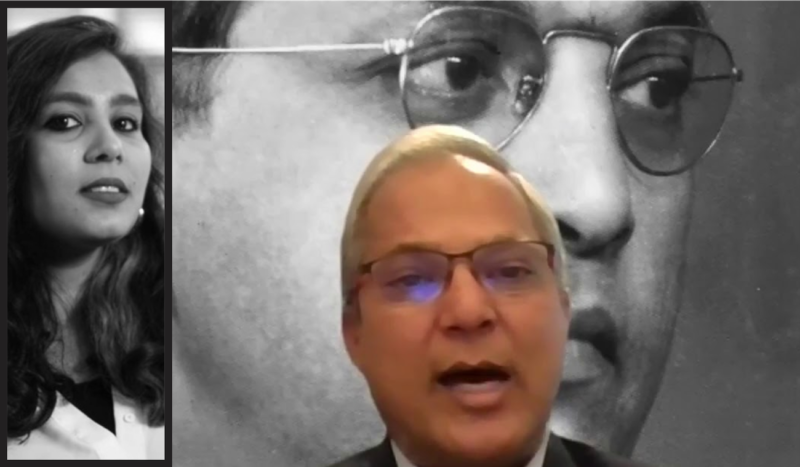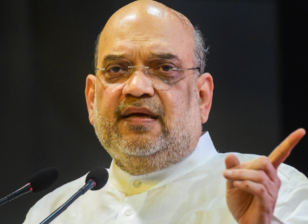‘We Always Exist On the Verge of Threat’: Do Dalit Lives Matter in America?
A conversation with the author of “Coming Out as Dalit” Yashica Dutt and anti-caste activist Anil Wagde.
India’s caste system is among the world’s oldest forms of social stratification. The system which divides people into rigid hierarchical groups based on their karma (work) and dharma (duty) is more than 3,000 years old. Caste is not officially recognized by law in the United States. It has, however, come into the limelight due to recent incidents of prejudice and forced labor.
I spoke with Yashica Dutt, a leading anti-caste expert, journalist and the award-winning author of the non-fiction memoir, “Coming Out as Dalit,” which was recently awarded the Sahitya Akademi Yuva Puruskar, 2020 (India’s National Academy of Letters’ Young Writers Award).
I also spoke with Anil Wagde, an Ambedkarite and an anti-caste activist. Wagde was at the forefront of filing an amicus brief in a California court on behalf of Ambedkar International Center (AIC).
Meera Kaul: In 2020, the caste-based discrimination in Silicon Valley came to the surface with a lawsuit against Cisco Systems filed by the California Department of Fair Employment and Housing and as amicus curiae by AIC. Since you filed the amicus brief against Cisco, Anil, could you tell us more about the basis of this case?
Anil Wagde: In the Cisco caste case, the upper caste discriminated against a lower caste subordinate by denying him good projects and promotions. When followed up with the human resources, Cisco took a stand that caste is not included in the discrimination policy. John Doe then approached the California Department of Fair Employment and Housing who recognized that the nature of discrimination was based on descent, birth, and national origin as practiced in the Indian subcontinent even though caste is not recognized as a discriminatory criterion here in the U.S.
Professor Kevin Brown of Indiana University has argued that the caste system is a type of racial, religious, and national origin discrimination. All are covered under Title Seven. The California Court had refused Cisco’s argument for arbitration between Cisco and John Doe. The decisions are pending review at the Appellate Court. Ambedkar International Center has filed an amicus brief explaining how the caste discrimination is real, how it operates, how it denies opportunities to people from lower castes, how people who are beneficiaries of the affirmative action like John Doe are looked down upon for benefiting from something that originates from the caste system.
Yashica Dutt: I just want to add to what Anil said. The issue of discrimination based on one’s caste, especially within the Indian American communities and within the South Asian diaspora in general is not new. This is something that the Dalits have experienced for a long time. I want to focus on India because we (the Dalits) are told that we don’t have merit and don’t deserve to be in positions of authority, whether in academia or in tech. We are told that we don’t deserve to do anything respectable because we have affirmative action.
If you read the Cisco lawsuit carefully, you will realize that the Indian Americans who John Doe was reporting about had first tried to investigate that person’s caste. They found out that the defendant was an affirmative action candidate through some alumni networks in India. As Dalit people, we not only have to undergo this discrimination, but we also must explain to people that it exists. And that is a uniquely American issue. Discrimination works at so many levels and which is why this Cisco lawsuit is a welcome intervention.
Meera Kaul: Thirty Dalit female engineers from Microsoft, Google, Apple, and other tech companies spoke about the kind of discrimination against them at work where they were physically, verbally abused by their bosses and their teams: calling them names, asking them to clean up, etc. This attitude stems from schools, back in India and carried forward to the rest of the world in educational institutions and companies. What are the bigger companies and institutions doing to take care of his kind of discrimination?
Yashica Dutta: There is a direct pipeline that exists from India to the United States. The welcome change is that South Asians in the United States have the kind of visibility and power that we’ve never had before. We are running tech companies, one of us is now a vice president. Ever since South Asian Americans have been in the U.S., we have created a culture of discrimination. To paraphrase Dr. B.R. Ambedkar “The Hindu is going to carry caste with him wherever he goes.” As the Hindu travels around the world, the caste system becomes a global problem.
Whether these companies are going to do something about this or not remains to be seen, but what is happening now is that people are unwilling to take this discrimination quietly. We’ve been taught that we should just be okay with it in schools and colleges back in India. The Dalit students just believe that they have no recourse, or they have nowhere to go to raise their voices, but of course, that culture is also changing. There is an excellent student activism network in universities by Dalits and Dalit students in India. In the U.S. as well, Dalit people are recognizing that they have the power, and they can speak up.
Another case with HCL brought the same issue into focus. There are people paying attention to the malice of the caste system, because with power and visibility also comes a greater spotlight to the issue.
Meera Kaul: Historically, dominant castes have used their caste privilege to gain citizenship in America. In 1923 A.K. Mozumdar and Bhagat Singh Thind argued that they passed the whiteness test because they were caste Hindus and had pure “Aryan” blood. Scientifically how that fits in escapes me, but one thing is sure — the privilege of some Indians is more than the privilege of the others and it is not based on their merit, their education, or what they’re capable of. How is this different than the racial discrimination against blacks or Hispanics?
The strategy is denialism. The argument is that casteism may exist in India, but it does not exist here. Whereas I can talk about Brahminical clubs, being formed in an organization like Microsoft. It is important to document this discrimination.
Anil Wagde: When a similar thing was mentioned in the California textbooks case which stated that the Aryans invaded India, different religious factions of our community rejected that argument and said that it was a controversial theory, whereas they used the same argument conveniently to obtain citizenship in the U.S. The caste system is in existence for thousands of years, and multiple movements like Buddhism, Jainism Sikhism, were created in response to caste discrimination. Many secular groups are trying to deny the existence of this caste discrimination.
When the Cisco case was filed, we invited several news reporters to discuss the case so that when people tell them their stories, the reporters may write about them. The stories reported included an anecdote of a person who was asked what their caste was in an interview here. In another case, a recruiter would tap on the other person on his shoulder to check whether that candidate wore a Brahmanical thread on his body.
Over 90% of the people, who are from the dominant community in the United States say they don’t see caste. But what happens is that children from my community are excluded from children’s play circles once our caste is revealed.
This is the reason why John Doe is so vehemently opposed to revealing his name. Should his name be disclosed, his children will not be allowed to play with other children in the apartment complex where he stays, and he will be victimized. A friend of mine accompanied someone to a wedding reception and they were asked their caste by the bride at the party.
Yashica Dutt: What we are discussing here is not just visible incidents of caste discrimination. We’re also discussing structural privileges. Dominant castes have benefited from privilege for centuries and sometimes do not even believe that caste discrimination exists. This is dangerous because the narrative that caste does not exist anymore makes the struggle of the people who are desperately trying to be seen and heard, invisible. That hurts the fight for the rights of the Dalits. That is why it took decades for a John Doe to come forward and protest this practice.
Meera Kaul: In 2015, the California State Board of Education initiated a regular ten-year public review of the school curriculum framework. The Hindu American Foundation (HAF) and a coalition of other Hindu activists sought to literally erase the word “Dalit” from the syllabus, which was contested by South Asian Histories for All Coalition, an interfaith, multi-racial, inter-caste coalition. This was opposed by a lot of interfaith coalitions who look at this action by HAF as one to deny history.
Yashica Dutt: Comparing racial oppression and discrimination that Black folks have undergone with the struggle of the Dalit people is fair. They’re obviously structurally like each other. We have so much in common, we have so much to learn from each other, but at the same time, they’re very different in specific ways. The racial discrimination against the Black folks is visible. When it comes to caste, discrimination is invisible. There are all these secret codes like how Anil explained by patting someone on their shoulders. To an onlooker who is non-South Asian, it will look like a regular pat on the back. A Dalit person would know exactly what is going on. How are people going to be educated about these dangerous discriminations that exist within us if they don’t even know what the word Dalit means. Therefore, it’s important for us to be educated about these issues.
I am going to go a step further and say that this idea where we think caste exists in the past is a very deliberate effort to make our stories irrelevant. By saying that caste is an internal issue or that it is something uniquely South Asian, is a cover for continuing the discrimination, harassment, assault, violence against Dalits. We will have no recourse to justice if no one understands what caste means. The power structures that kept upper-class dominance for thousands of years will continue to have power over the narrative.
Meera Kaul: In May 2021, the FBI raided Akshardham in Robbinsville Township, New Jersey, to investigate forced labor of lower caste Indian workers. The workers were brought on religious visas and the FBI removed about 90 workers from the site. On one hand, we are told let’s not put “caste” in our books or let’s not even talk about it, but on the other hand, we are openly creating unlawful precedents in terms of caste discrimination.
Anil Wagde: The strategy is denialism. The argument is that casteism may exist in India, but it does not exist here. Whereas I can talk about Brahminical clubs, being formed in an organization like Microsoft. It is important to document this discrimination.
Much of the problem will be solved if the Hindus accept that there is a caste problem, only then we can take the corrective measures. The FBI and others should investigate how all the other temples were built too. This is clearly an exploitative practice. People have tried to justify saying that we are paying the median wages while making a mockery of the entire American judicial system.
Meera Kaul: There is a school of thought that believes there is casteism in premier educational institutions where a majority of the professors are upper caste, and that many Dalit professors, students, and workers, always have faced systemic discrimination, bullying and ostracization.
Yashica Dutt: One of the main focal points is that Dalits were denied education. We owe it to Dr. Ambedkar for ensuring affirmative action, otherwise, we wouldn’t have been sitting here across the table from you speaking about this. At the same time, these higher institutes of learning have also become hotbeds of caste ideology where they believe Dalits don’t deserve to be in these higher places of learning, and these attitudes are engendered throughout the country.
For immigrants coming to the U.S., these regressive ideas and practices come from their experiences in India. Some of the worst kinds of discrimination come from Indian American academics in the academia here. Students on campuses talk about how they are not a part of the South Asian larger groups because of the ill-treatment by other Indian students and the teachers. The caste-based discrimination culture of the South Asian subcontinent is a cultural problem in the U.S. now.
Anil Wagde: I was invited to a couple of places to talk about diversity. The first backlash comes from the Indians because they do not want to talk about caste. Thank you very much for bringing us to this platform and making this platform available to talk. Denialism must be taken care of.
In some cases when we mentioned caste in various organizations, they weren’t open to discussions, fearing a backlash from their Indian workforce. This is nothing but Brahminical supremacy. It is exactly like white supremacy. Unless there is a conscious effort made by the universities and organizations, this will never go away.
California is very much at the forefront to recognize caste discrimination. Santa Clara county had held a caste hearing to make caste-based disadvantaged groups a protected category, Google employees have accepted that caste must be addressed, the California Student Body has accepted it as well. These are baby steps. All these organizations have an enormous responsibility in making this happen.
Meera Kaul: There are caste-based killings in America, we have honor killings in communities that have immigrated from Asia or Africa. You would think that these practices do not exist here.
Anil Wagde: We are just an extension of what is happening in India. These practices are happening in our neighborhoods. The solution is about being open to look at the biases that exist within you. If you support your own civil rights as a citizen in this country, there is no reason why you should strip a part of your own community of its basic rights as enshrined in the Constitution.
Meera Kaul: Many Dalit women came out to say that they faced rape and death threats to intimidate them when they spoke about caste discrimination.
Yashica Dutt: I came out as a Dalit person in 2016 in a Facebook note, when I just graduated from Columbia here in New York. I decided to sort of use my identity lens to tell my story very similar to what we see in terms of our sexuality.
Dalits have been forced to hide their identities to lie about the past, just to survive. This is a very similar concept to what you’ve seen among Black folks who if they are a little light-skinned enough to be able to pass as white Americans, took that opportunity because that gave them a better life. There have been death threats, risk of bodily harm. It is hard to be on the margins and be a woman. In terms of structural power, there is very little power that somebody like me, or other Dalit women can claim. We always exist on the verge of threat.
I had to really think twice but what consequences I may face for this. How much am I going to be trolled on Twitter, or how much I would be abused on Instagram, just for having a voice. I’m going to be invalidated. I’m going to be told that my experiences are false, that I don’t exist. That my idea of myself is wrong.
We need to stand for the rights of the ones oppressed for centuries for no viable reason except sheer narrow-mindedness. Everyone is the same at the cellular level and we need to increase our aperture to rethink our society and its rules. The first step towards this is to accept that we have a problem that needs to be fixed.
Meera Kaul is a Silicon Valley-based author and contributor with an interest in writing about political systems, economic and legal frameworks, foreign relations, policies, and ideologies. 26+ years of experience in executing ventures across three continents. She is a Thomas Jefferson School of Law and Stanford GSB Alum.




